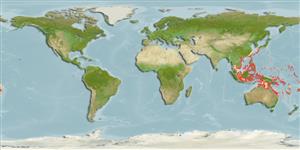Common names from other countries
Environment: milieu / climate zone / depth range / distribution range
Sinh thái học
Cùng sống ở rạn san hô; Mức độ sâu 0 - 40 m (Ref. 848). Tropical; 36°N - 34°S, 80°E - 137°W (Ref. 848)
Indo-Pacific.
Length at first maturity / Bộ gần gũi / Khối lượng (Trọng lượng) / Age
Maturity: Lm ? range ? - ? cm
Colony: massive, often small. Plocoid to tubular corallites. Primarily extratentacular budding. Equal and well developed costae. Often poorly developed paliform lobes. Small and compact columellae. Tentacles extend only at night. Color often brown, cream, or green with pale oral discs (Ref. 848).
Known from shallow reef environments, especially reef backs away from strong wave action (Ref. 848). Has low to moderate bleaching level in Palau (Ref. 66144).
Life cycle and mating behavior
Chín muồi sinh dục | Sự tái sinh sản | Đẻ trứng | Các trứng | Sự sinh sản | Ấu trùng
Hermaphroditic (Ref. 113712). Mature gametes are shed into the coelenteron and spawned through the mouth. Life cycle: The zygote develops into a planktonic planula larva. Metamorphosis begins with early morphogenesis of tentacles, septa and pharynx before larval settlement on the aboral end (Ref. 833).
Veron, J.E.N. 2000. (Ref. 848)
IUCN Red List Status (Ref. 130435)
CITES status (Ref. 108899)
Not Evaluated
Human uses
| FishSource |
Các công cụ
Thêm thông tin
Age/SizeSự sinh trưởngLength-weightLength-lengthHình thái họcẤu trùngSự phong phú
Các nguồn internet
Estimates based on models
Preferred temperature
(Ref.
115969): 25 - 28.9, mean 27.6 (based on 300 cells).
Price category
Unknown.
